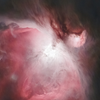


Amateur astronomer and astrophotographer, member of AAVSO.
This profile is from a federated server and may be incomplete. Browse more on the original instance.


Amateur astronomer and astrophotographer, member of AAVSO.
This profile is from a federated server and may be incomplete. Browse more on the original instance.